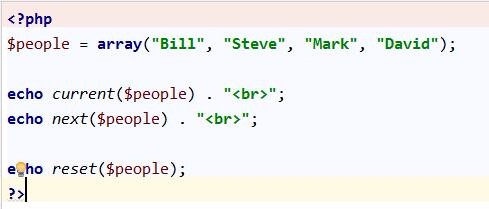10 recommended articles about array operations
The current() function in php returns the current element (unit) in the array. Each array has an internal pointer pointing to its "current" unit, which initially points to the first unit inserted into the array. If we execute current once, the internal pointer will point to the next unit, and we can use current to get the value of the current unit in the array. This article collects several articles on the usage of PHP's array operation function current(). I hope it will be helpful to everyone's understanding of array operations. 1.php array function current() definition and usage The current() function in php returns the current element (unit) in the array. If the current element is empty or the current element has no value, it returns FALSE. Each array has an internal pointer pointing to its "current" element, which initially points to the first element inserted into the array. This function does not move the internal pointer of the array. If you need to move the pointer, you need to cooperate with other functions. Let’s take a look. 2. Detailed explanation of php end() function and current() function usage examples in php end
1. php returns elements in the array current() function usage summary

Introduction: The current() function in PHP returns the current element (unit) in the array, and there is one in each array The internal pointer points to its "current" unit, initially pointing to the first unit inserted into the array. If we execute current once, the internal pointer will point to the next unit. We can use current to get the current unit in the array. value. This article collects several articles on the usage of PHP's array operation function current(). I hope it will be helpful to everyone's understanding of array operations.

Introduction: The current() function in PHP returns the current element (unit, which is the first element of the array) in the array. The next() function points the internal pointer to the next element in the array. element and output the value of the element. The reset() function points the internal pointer to the first element in the array and outputs the value of the element. This article mainly introduces the usage of current, next and reset functions in PHP. The example form details the specific usage of the functions current, next and reset for array operations in PHP. It has certain reference value for in-depth understanding of the usage of arrays. I hope it will be helpful to everyone's understanding of arrays
3. Java Basics Summary of Common Array Operations (Collection)

Introduction: The editor below will bring you a summary of common Java basic array operations (a must-read article). I think it is quite good, so I will share it with you now and give it a reference. Bar
4. WeChat applet to learn array operations

Introduction: Preface I believe that after the mini program was launched in public beta, many friends have rushed to apply for registration of the mini program. During the development stage, they also encountered many problems, such as wx.request data request being unsuccessful and array operations. Sometimes, I don’t know how to push data into the array, how input monitors the status of user input, the background image of css cannot obtain local resources, etc. This blog will have a special topic to give solutions to the array operations today for friends who encounter these problems. We mainly talk about array operations. I believe that for those who have used vu...
##5. When to create a MySQL index

Introduction: Indexes can improve data retrieval efficiency and reduce database IO costs, and indexes can also reduce database sorting costs. Sorting and grouping operations mainly consume CPU resources and memory, so making good use of indexes in sorting and grouping operations will greatly reduce the consumption of CPU resources. How to determine whether to create an index? 1. We all know the fields that are frequently used as query conditions. What
6. Detailed sample code for JavaScript array operation function methods

Introduction: 1. concat() concatenates two or more arrays. This method does not change the existing array, but only returns a copy of the concatenated array. For example: 1
AI-powered app for creating realistic nude photos Online AI tool for removing clothes from photos. Undress images for free AI clothes remover Swap faces in any video effortlessly with our completely free AI face swap tool! Easy-to-use and free code editor Chinese version, very easy to use Powerful PHP integrated development environment Visual web development tools God-level code editing software (SublimeText3)
Hot AI Tools

Undresser.AI Undress

AI Clothes Remover

Undress AI Tool

Clothoff.io

Video Face Swap

Hot Article

Hot Tools

Notepad++7.3.1

SublimeText3 Chinese version

Zend Studio 13.0.1

Dreamweaver CS6

SublimeText3 Mac version

Hot Topics
 Alipay PHP SDK transfer error: How to solve the problem of 'Cannot declare class SignData'?
Apr 01, 2025 am 07:21 AM
Alipay PHP SDK transfer error: How to solve the problem of 'Cannot declare class SignData'?
Apr 01, 2025 am 07:21 AM
Alipay PHP...
 How does session hijacking work and how can you mitigate it in PHP?
Apr 06, 2025 am 12:02 AM
How does session hijacking work and how can you mitigate it in PHP?
Apr 06, 2025 am 12:02 AM
Session hijacking can be achieved through the following steps: 1. Obtain the session ID, 2. Use the session ID, 3. Keep the session active. The methods to prevent session hijacking in PHP include: 1. Use the session_regenerate_id() function to regenerate the session ID, 2. Store session data through the database, 3. Ensure that all session data is transmitted through HTTPS.
 Explain JSON Web Tokens (JWT) and their use case in PHP APIs.
Apr 05, 2025 am 12:04 AM
Explain JSON Web Tokens (JWT) and their use case in PHP APIs.
Apr 05, 2025 am 12:04 AM
JWT is an open standard based on JSON, used to securely transmit information between parties, mainly for identity authentication and information exchange. 1. JWT consists of three parts: Header, Payload and Signature. 2. The working principle of JWT includes three steps: generating JWT, verifying JWT and parsing Payload. 3. When using JWT for authentication in PHP, JWT can be generated and verified, and user role and permission information can be included in advanced usage. 4. Common errors include signature verification failure, token expiration, and payload oversized. Debugging skills include using debugging tools and logging. 5. Performance optimization and best practices include using appropriate signature algorithms, setting validity periods reasonably,
 Describe the SOLID principles and how they apply to PHP development.
Apr 03, 2025 am 12:04 AM
Describe the SOLID principles and how they apply to PHP development.
Apr 03, 2025 am 12:04 AM
The application of SOLID principle in PHP development includes: 1. Single responsibility principle (SRP): Each class is responsible for only one function. 2. Open and close principle (OCP): Changes are achieved through extension rather than modification. 3. Lisch's Substitution Principle (LSP): Subclasses can replace base classes without affecting program accuracy. 4. Interface isolation principle (ISP): Use fine-grained interfaces to avoid dependencies and unused methods. 5. Dependency inversion principle (DIP): High and low-level modules rely on abstraction and are implemented through dependency injection.
 How to debug CLI mode in PHPStorm?
Apr 01, 2025 pm 02:57 PM
How to debug CLI mode in PHPStorm?
Apr 01, 2025 pm 02:57 PM
How to debug CLI mode in PHPStorm? When developing with PHPStorm, sometimes we need to debug PHP in command line interface (CLI) mode...
 How to automatically set permissions of unixsocket after system restart?
Mar 31, 2025 pm 11:54 PM
How to automatically set permissions of unixsocket after system restart?
Mar 31, 2025 pm 11:54 PM
How to automatically set the permissions of unixsocket after the system restarts. Every time the system restarts, we need to execute the following command to modify the permissions of unixsocket: sudo...
 Explain late static binding in PHP (static::).
Apr 03, 2025 am 12:04 AM
Explain late static binding in PHP (static::).
Apr 03, 2025 am 12:04 AM
Static binding (static::) implements late static binding (LSB) in PHP, allowing calling classes to be referenced in static contexts rather than defining classes. 1) The parsing process is performed at runtime, 2) Look up the call class in the inheritance relationship, 3) It may bring performance overhead.
 How to send a POST request containing JSON data using PHP's cURL library?
Apr 01, 2025 pm 03:12 PM
How to send a POST request containing JSON data using PHP's cURL library?
Apr 01, 2025 pm 03:12 PM
Sending JSON data using PHP's cURL library In PHP development, it is often necessary to interact with external APIs. One of the common ways is to use cURL library to send POST�...






